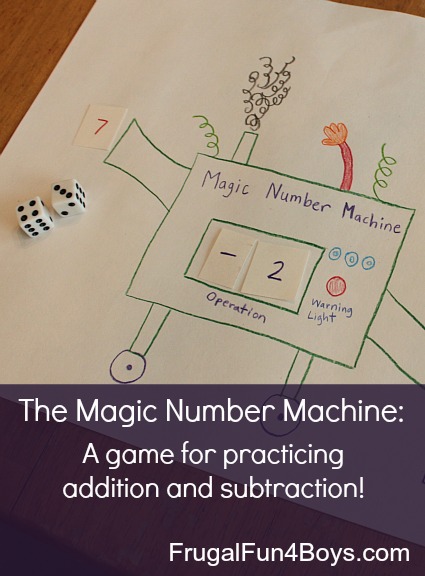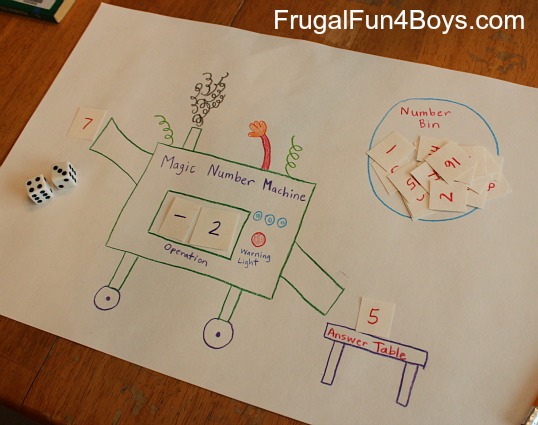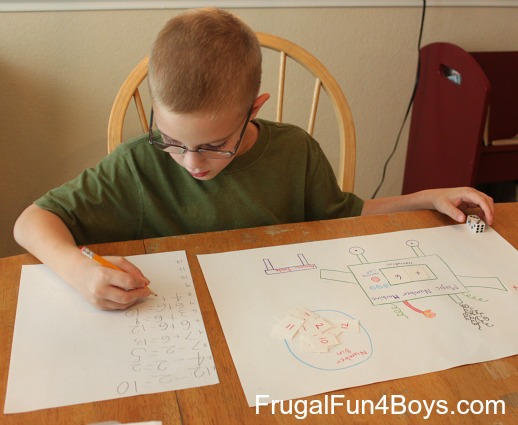It’s almost August, and time to start our homeschool year! We usually start the last week of July, but with our vacation last week and then needing this week to recover from vacation, we’re kind of easing into things. My plan is to start new math and language books this week. Next week we’ll begin doing all of our subjects except history, which we don’t have yet (Sonlight Cores B and F). I’m planning to put a post together with our curriculum choices for the year – once I make one more trip to the store for handwriting and vocab. books. Nothing like waiting until the last minute… I’m usually more ahead of the game than this! I really like starting the school year early. It’s a rare week that we manage to complete five days of school, so by starting a month ahead of the public schools, I never really feel the pressure of being “behind.”
Anyway, here is a fun math game for 5-7 year old’s that will help kids review their math facts, or get a head start on the new school year!
The gameboard is simple. I drew a math machine with an entrance and an exit and a box in the middle. For the mathematical operation part, I made two cards with “+” and “-” and then cards with the numbers 1 through 6 on them. Then I drew a circle to be the “number bin.” For this circle, I made number cards with the numbers 1 through 20 on them.
To play, I had Gresham choose an operation – either addition or subtraction. Then, he rolled one die to determine how many the machine would add or subtract. Then, he rolled both dice to see what number to put into the machine.
I had him record his math sentences on a separate piece of paper. We did 3-4 rounds of each operation, and then changed operations.
I plan to do this game another day to work specifically on patterns. I can have him number his page from 12 to 1, and then do the same operation for each number so that he gets a pattern like this:
12 – 2 = 10
11 – 2 = 9
10 – 2 = 8
9 – 2 = 7
And so on.
Our homeschooling has been sort of history and science heavy, so at the moment I am working on adding in new math activities. We have always stayed up to date in our math books, but I want to add more hands-on number sense types of things. So stay tuned for more math posts!
Here are a few more math ideas that we have done in the past:
And more math ideas:
- For younger kids who are just starting to add, I LOVE this adding and counting machine from The Imagination Tree!
- Here is a HUGE round-up of math ideas for kindergarten and first grade from Creekside Learning.




4 Comments
Jannapy Jul 31, 2013
We did public school for kindergarten last year and were reminded again how much time is wasted in the public school system on non-educational activities. I don't think you have any worries about getting behind when you don't do a 5 day school week. I completed my education at private Christian schools and we are sending our now 1st grader to one this Fall.
Kara @SimpleKids.net Aug 7, 2013
This is great! :-)
And, we're doing Sonlight Core F, too so I'm looking forward to reading about your experience with it. (We're mainly following the book list, not the day by day lesson plans this year) I'm writing about it at our homeschool blog http://dynamorhino.com
Thanks for sharing this game - looks like a fun teaching tool!
Best wishes,
Kara
ledenika Aug 8, 2013
Hi! I read the article and was inspired to play this game with my kids (4 and 6 years). Thanks for the idea!
but I do have one question: how do you play, if it turns out like 2-5 = or other negative numbers?
Sarah Aug 8, 2013
Great question! I meant to cover this in the post and then forgot. I told Gresham to write the sentence (2-5 or whatever) and then write "can't solve." His math curriculum (Making Math Meaningful) routinely throws in problems like that and the kids are supposed to figure out that they can't do it. I think it's good to keep them thinking!
Mathmama May 23, 2014
I'm a high school math teacher and this is how I teach functions to my algebra and algebra 2 students. I can't tell you how much I love that you are doing this early. It gives them a great concept of how high level math works at a very early age . If your kids are advanced, you could have them run the machine backwards too. That is how I teach the high schoolers about inverse functions. And I would have them do the negatives. You'll be surprised what some very young kids can understand with very little teaching. Its a little abstract but some kids will absolutely get it especially if you use money or payment style. like you give your brother 5 pieces of candy and he says he will pay you back when he gets home but when you get home he only has 2 pieces of candy. How many pieces of candy does he owe you? so how many pieces of candy does he have?
Post a Comment